
تاريخ الفيزياء

علماء الفيزياء


الفيزياء الكلاسيكية

الميكانيك

الديناميكا الحرارية


الكهربائية والمغناطيسية

الكهربائية

المغناطيسية

الكهرومغناطيسية


علم البصريات

تاريخ علم البصريات

الضوء

مواضيع عامة في علم البصريات

الصوت


الفيزياء الحديثة


النظرية النسبية

النظرية النسبية الخاصة

النظرية النسبية العامة

مواضيع عامة في النظرية النسبية

ميكانيكا الكم

الفيزياء الذرية

الفيزياء الجزيئية


الفيزياء النووية

مواضيع عامة في الفيزياء النووية

النشاط الاشعاعي


فيزياء الحالة الصلبة

الموصلات

أشباه الموصلات

العوازل

مواضيع عامة في الفيزياء الصلبة

فيزياء الجوامد


الليزر

أنواع الليزر

بعض تطبيقات الليزر

مواضيع عامة في الليزر


علم الفلك

تاريخ وعلماء علم الفلك

الثقوب السوداء


المجموعة الشمسية

الشمس

كوكب عطارد

كوكب الزهرة

كوكب الأرض

كوكب المريخ

كوكب المشتري

كوكب زحل

كوكب أورانوس

كوكب نبتون

كوكب بلوتو

القمر

كواكب ومواضيع اخرى

مواضيع عامة في علم الفلك

النجوم

البلازما

الألكترونيات

خواص المادة


الطاقة البديلة

الطاقة الشمسية

مواضيع عامة في الطاقة البديلة

المد والجزر

فيزياء الجسيمات


الفيزياء والعلوم الأخرى

الفيزياء الكيميائية

الفيزياء الرياضية

الفيزياء الحيوية

الفيزياء العامة


مواضيع عامة في الفيزياء

تجارب فيزيائية

مصطلحات وتعاريف فيزيائية

وحدات القياس الفيزيائية

طرائف الفيزياء

مواضيع اخرى
Electron Effective Mass
المؤلف:
Donald A. Neamen
المصدر:
Semiconductor Physics and Devices
الجزء والصفحة:
p 73
14-5-2017
860
Electron Effective Mass
The movement of an electron in a lattice will, in general, be different from that of an electron in free space. In addition to an externally applied force, there are internal forces in the crystal due to positively charged ions or protons and negatively charged electrons, which will influence the motion of electrons in the lattice. We can write
 (1)
(1)
where Ftotal, Fext, and Fint, are the total force, the externally applied force, and the internal forces, respectively, acting on a particle in a crystal. The parameter a is the acceleration and m is the rest mass of the particle.
Since it is difficult to take into account all of the internal forces, we will write the equation
 (2)
(2)
where the acceleration a is now directly related to the external force. The parameter m*. called the effective mass, takes into account the panicle mass and also takes into account the effect of the internal forces.
To use an analogy for the effective mass concept, consider the difference in motion between a glass marble in a container filled with water and in a container filled
with oil. In general, the marble will drop through the water at a faster rate than through the oil. The external force in this example is the gravitational force and the internal forces are related to the viscosity of the liquids. Because of the difference in motion of the marble in these two cases, the mass of the marble would appear to be different in water than in oil. (As with any analogy, we must be careful not to be too literal.)
We can also relate the effective mass of an electron in a crystal to the E versus k curves. In a semiconductor material, we will be dealing with allowed energy hands that are almost empty of electrons and other energy bands that are almost full of electrons.
To begin, consider the case of a free electron whose E versus k curve. Recalling Equation (3.28). the energy and momentum are related by E = p2/2m = h2k2/2m, where m is the mass of the electron. The momentum an wave number k are related by p = hk. If we take the derivative of Equation (3.28) with respect to k, we obtain
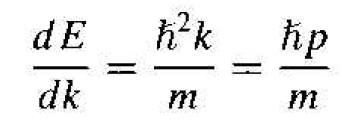 (3)
(3)
Relating momentum to velocity, Equation (3) can be written as
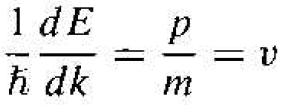 (4)
(4)
where v is the velocity of the particle. The first derivative of E with respect to k is related to the velocity of the panicle.
If we now take the second derivative of E with respect to k, we have
 (5)
(5)
We may rewrite Equation (5) as
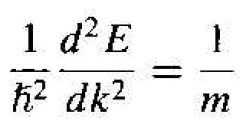 (6)
(6)
The second derivative of E with respect to k is inversely proportional to the mass of the particle. For the case of a free electron, the mass is a constant (nonrelativistic effect), so the second derivative function is a constant. We may also that d2E/dk2 is a positive quantity, which implies that the mass of the electron is also a positive quantity.
If we apply an electric field to the free electron and use Newton's classical equation of motion, we can write
 (7)
(7)
where a is the acceleration, E is the applied electric field, and e ih the magnitude of the electronic charge. Solving for the acceleration, we have
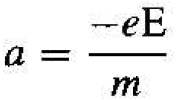 (8)
(8)
The motion of the free electron is in the opposite direction to the applied electric field because of the negative charge.
We may now apply the results to the electron in the bottom of an allowed energy band. Consider the allowed energy band in Figure 1.1. The energy near the bottom of this energy band may be approximated by a parabola, just as that of a free particle. We may write
 (9)
(9)
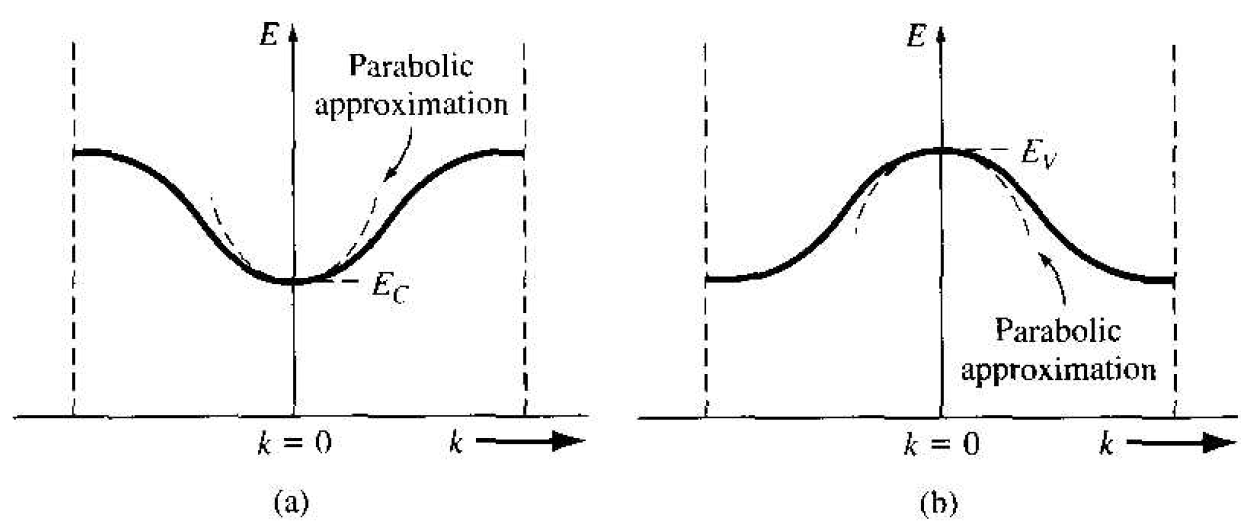
Figure 1.1 (a) The conduction band in reduced k space, and the parabolic approximation. (b) The valence band in reduced k space, and the parabolic approximation.
The energy E, is the energy at the bottom of the band. Since E > Ec, the parameter C1 is a positive quantity.
Taking the second derivative of E with respect to k from Equation (9), we obtain
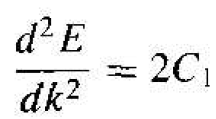 (10)
(10)
We may put Equation (10) in the form
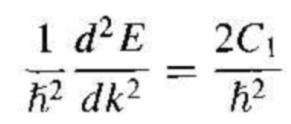 (11)
(11)
Comparing Equation (11) with Equation(6), we may equate h2/2C1 to the mass of the particle. However, the curvature of the curve in Figure 1.1a will not, in general, be the same as the curvature of the free-particle curve. We may write
 (12)
(12)
where m* is called the effective mass. Since C2 > 0, we have that m* > 0 also.
The effective mass is a parameter that relates the quantum mechanical results to the classical force equations. In most instances, the electron in the bottom of the conduction band can be thought of as a classical particle whose motion can be modeled by Newtonian mechanics, provided that the internal forces and quantum mechanical properties are taken into account through the effective mass. If we apply an electric field to the electron in the bottom of the allowed energy band, we may write the acceleration as
 (13)
(13)
where m*n is the effective mass of the electron. The effective mass m*n of the electron near the bottom of the conduction band is a constant.
 الاكثر قراءة في الموصلات
الاكثر قراءة في الموصلات
 اخر الاخبار
اخر الاخبار
اخبار العتبة العباسية المقدسة

الآخبار الصحية















 قسم الشؤون الفكرية يصدر كتاباً يوثق تاريخ السدانة في العتبة العباسية المقدسة
قسم الشؤون الفكرية يصدر كتاباً يوثق تاريخ السدانة في العتبة العباسية المقدسة "المهمة".. إصدار قصصي يوثّق القصص الفائزة في مسابقة فتوى الدفاع المقدسة للقصة القصيرة
"المهمة".. إصدار قصصي يوثّق القصص الفائزة في مسابقة فتوى الدفاع المقدسة للقصة القصيرة (نوافذ).. إصدار أدبي يوثق القصص الفائزة في مسابقة الإمام العسكري (عليه السلام)
(نوافذ).. إصدار أدبي يوثق القصص الفائزة في مسابقة الإمام العسكري (عليه السلام)


















